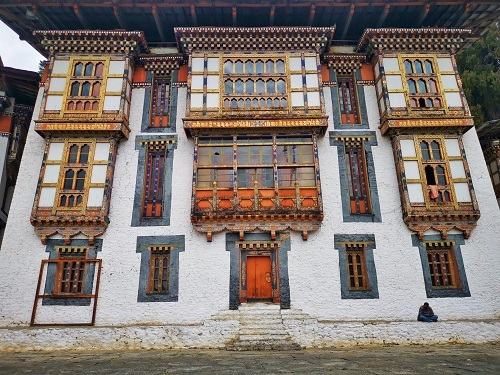Kurjey Lhakhang, is one of the most holy and sacred sites in Bhutan, located in the Bumthang district. Nestled on the side of a hill, surrounded by 108 chorten walls, the complex houses three revered temples, namely: Guru Lhakhang, Sampa Lhundrup Lhakhang and Ka Gon Phor Sum Lhakhang.
The structures of the temples are as magnificent as the dzong, ancient fortresses in Bhutan. It has white washed walls with delicate wood carvings and hand paintings.
What does "Kurjey" mean?
During the 8th Century, Sendhu Raja, the king of Bumthang at that time, fell ill. He invited Guru Rinpoche who brought Buddhism to Bhutan to cure him. Guru Rinpoche found out that the king’s illness was caused by the malevolent actions of the local deities including the powerful Shelging Karpo. Having found the cause of the illness, Guru Rinpoche chased the deities into a cave, and meditated inside for three months. Guru Rinpoche then subdued the deities including the powerful Shelging Karpo and left his body imprint inside the cave, thus, giving the name Kurjey (Body Imprint). Kur means body, Jey is imprint while lhakhang means temple. Beside the monastery is a tall cypress tree that is believed to have sprouted from the walking stick of Guru Rinpoche.
Architecture of Kurjey Lhakhang
The first of the three temples, the Guru Lhakhang, is the oldest and was built in 1652. Tucked just below the caves is a figure of a snow lion with a jachung (also called garuda) above it, which represents the famous struggle between Guru Rinpoche (appearing as the garuda) and the local demon, Shelging Kharpo (as the snow lion). The statue of Shelging Kharpo inside the temple is hidden from view.
At the entrance to the lower-floor of Sangay Lhakhang, there is a small crawl-through rock passage. Bhutanese believe that by crawling through the narrow tunnel, you will leave your sins behind. Behind the statues of the three Buddhas is a secret passageway that is said to have once led to Tharpaling.
The second temple, the Sampa Lhundrup Lhakhang, was built by Ugyen Wangchuck, the first king of Bhutan, in 1900 when he was still penlop of Trongsa. It is built on the site of a cave containing a rock with the imprint of Guru's body and is therefore considered the most holy.
The third temple was built in 1984 by Ashi Kesang Wangchuck, the Queen Mother (Queen to the third king of Bhutan) under the guidance of Dilgo Khyentse Rinpoche.

The temple offers a spectacular view of the Bumthang valleys. From Kurjey Lhakhang, you can also explore the mesmerising apple orchards and dairy farms nearby.
About Kurjey Tshechu
Kurjey Lhakhang hosts an annual festival known as the Kurjey Tshechu. This religious festival is held in the tenth month of the Bhutanese lunar calendar – typically held in the month of June – and features masked dances (Cham), religious rituals, and cultural performances. The highlight of the festival include religiously significant dances such as Guru Tshengye and Shinjay cham performed by the monks of Kurjey Lhakhang that depicts stories from Buddhist mythology and serves to impart blessings and teachings to the audience.
